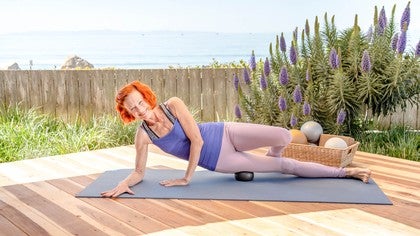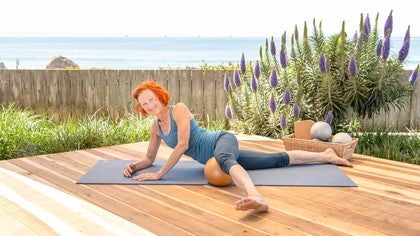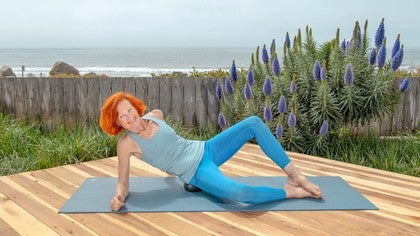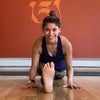Description
You will need all the props you have from Yamana USA®.
About This Video
Transcript
Read Full Transcript
In today's class, we're going to do a Follow Along where we cover all the routines we learned in the prior lessons, so you just have a practice format where you go through all of them. Remember, two minutes is the minimum to bring around the profound change you need in your own body. As we go through some of these routines, if you find that areas of your body are asking for more time or to stay right in that spot because it's more knotted, more painful, more stock and kind of congested feeling, do so, this is your practice, your body, you use it up level everything about who you are and keep yourself functional and young and vibrant and get the stress out. Make sure you have all your props. Every ball you've got, pillows, blocks, the whole enchilada because the more kind of variety you have, you will find you can utilize it.
I've even had people do these routines on foam rollers, which I was not recommending. And they email me and say, wow, that was the best transformation I've ever experienced. So let us never be the same again. And we will start with the quads. Again, any ball you want, any size, placing it up at the hipbone, lifting up the lower back, taking a moment to lengthen out the leg, big breath, making sure you're sunk in and not dropped and ride forward towards the groin area.
And from this point on, just take your time. We're lengthening out the whole shaft of the muscle. If something feels like you really want to do it, I'd love to go side to side and feel it for yourself. Oh, this is the beginning of the big monster, you could say. So our bodies also have an emotional component to them.
We never really think of this, but we are a total organism body, mind and spirit. Our bodies are the map of our whole life. Every experience, every memory, every emotion that we have had in our life is part of the fabric of the physical body as well. I normally don't mention this, but I have seen and had people share with me really a profound change in their personality as they soften up and up level who they are because you're allowing trauma to leave your whole body. Moving down.
So our legs represent being able to take a stand on our life, being able to hold our ground, being able to walk towards our dreams. There are many components to this. So, start to notice, do you actually feel like a different person when you're doing this work? Is there something new or very familiar, but old coming into your personality? Because a lot of it can come to the surface as you release this from your body.
So again, feel around, just let yourself work with the body you've got and sink into areas that you feel really tight. See if you can soften them. Right here in the center of the muscle I can feel a lot of tightness. The other thing is of course, rolling the knee out a little bit, externally rotating, so I'm clumping over the shaft. So again, your body, listen to it, see what you want to do.
And if something specific really attracts you, go for it. Right across the knee. Rolling back up and the other side. So right at the top at the hip, by the way, that was two minutes, checking hips, the same height, backlog. So we're lengthening the quad, opening it up.
I find that as I really place my pelvis correctly and just start gently lifting and lowering, I can feel the glute muscles starting to kick in, as they should, as the backline support of the body. Very often, they end up being lower back instead, going right into the groin just below, even lifting up a little bit, moving into the shaft, again, does one leg feel really different than the other? Do you have one muscle group that's much stronger? Do you tend to stand on one leg more than the other? You're going to have that come face to face as you walk through this work or roll through the work.
What am I thinking? I'm going right on top of the muscle shaft. Another option you can do is literally gently building the knee a little bit. Can you sink into the muscle as you do this? So you're widening and stretching the fibers.
Moving further, again, rolling out again, checking that I'm not hiking up, not sinking down, that defeats the purpose that just weakens the structure. All the way up, rolling to the knee coming off and our next one are the glutes. So choose your ball. I'm gonna work with this black ball, starting out with glute major, that corner area, getting on, feeling in, sinking into the ball. This is one that over time I like to work harder and harder and harder ball and very slowly, (exhales) rolling out on a diagonal and down towards the top of your femur.
Getting into that area, right here, it's nice and tight, I'm gonna spend a moment. Build into our language is the emotional language of the body. And it has a deep and profound truth to it. People that are gripping or don't have the ability to move and shift and change very easily, become stubborn, usually have a lot of stuff going on in the back part of the pelvis. It's kind of a harmonic.
So just for fun, check into yourself. Rolling into it, now I'm coming back, next part down a little bit low on the sacrum. Rolling out to deepen the work. I'm bending, oh, and slowly right here. Sinking in, taking that time.
Opening up. It's so freeing on the hips. So you want to have the power in the glutes area huge source of power. So I'm propelling the body forward in space, making it stable. Genetically coming back to the lowest part of the sacrum.
If you think of an animal, have you ever seen a dog run fast to watch the tiger or lion in the wild? They have a huge amount of power in their pelvis. Their pelvis is what propels their whole lower body into power. And we have that built into our DNA. We kind of forgot about it, but it's built in there and you can see it in really strong runners and top level athletes, how strong their hips and pelvis is and the glutes fire, because they're having a relationship between the lower body and the upper body to come to balance all the time.
Oh, such a good feeling, all the way out. Very good, we'll do the same with the other side. So grabbing the high corner of your glute max right there between the ridge of the pelvis and the muscles right the cradle into the spine top of the sacrum area, sinking in can be lower. No, I don't like this position as much. This position gets me deeper in.
So fiddle around, find what can you do in your body to really traction that muscle, soften its connection to the bone. Oh, rolling out, right here I can feel a lump that wants to resist. Come on, you're gonna roll through and become elastic. There, just released. I'm on my diagonal out, rolling out towards the side of the hip.
That was a beautiful role. When you get it to release properly, it feels so delicious. Moving down on top of the sacrum because it just rolls through, you feel this complete good quality massage that you're giving yourself. And you're also pushing the lymph and allowing again, a cleansing and a hydration that comes into the tissue. Rolling out, all the way, right out riding that pelvis, releasing any congestion that may be gripping into the sacrum or going through the piriformis, the lowest part of the sacrum, you're running just above the sit bone now.
Rolling out. Remember that sciatic nerve that people saying, oh, I have a pinch nerve. My doctor told me to have a pinched nerve and that's causing my sciatica, this is how you're gonna get the space for that nerve to slide back where it belongs and allow the femur to release more and be more relaxed in the joint and the lower back to be more relaxed and free. Our glutes when they work right, have a perky shape to them. Oh, all the way out. So good.
Coming off, I'm gonna shift into glute medius and minimus. Remember they running more on the side of what the shape of your bottom is, and I'm shifting into a harder ball for myself. You can do it with a black ball, tennis ball, whatever you feel ready for. Top here, sinking in. Oh yes, this one usually gets very tight for people and it is an amazing power.
Remember it balances your pelvis. It means if you have one hip hiked up, it can be one of the reasons you have an imbalance in your pelvis and unsticking that over tight muscle over shortened muscle can help. So I'm slowly just riding down. This one can give me almost a headache feeling in my butt. Oh, but the relief is so profound.
Great to do before you get on the reformer and do your foot work because the muscles of the leg become so responsive and stimulated and interactive, and the glutes naturally should have a round shape at the base, in the area, basically the back of the pelvis. Remember we don't want them drop down and they atrophy to a certain extent and kind of collapse. And then the lower back is getting an unnecessary burden and we want to restore that perky, responsive interactive muscle. We want to be vibrant and have support. I'm going all the way down.
I'm getting real close to the top of the femur. I can feel myself literally stretching the femur out a little bit because that's where the muscle connects in. Very good, coming off, going to the other side. Right at the top on the side of the glute. Glute medius and minimus, getting into that side, sinking into it.
Yeah, definitely, I get a headache here (laughs) and I love it because I can feel the shaft connection between this glute muscle and my maximus muscle. So they have some kind of a song and dance going on. I'm doing slight on this side, micro movements forward and back, slowly dragging the ball down. Sometimes I like to move the leg a little bit to check the connection of the muscle that I'm working on, that I'm tractioning and forcing to expand right where the ball is. Oh, it just moved into another place.
And when you do movements with the limbs close by, you can feel the pull of the connective tissue into the other muscle groups and joints. And often if you feel a real strong pull or a painful pull, that means you've got some dehydration and congestion and glued up textures within the fascia. Rolling down, I'm getting right close to my femur, pressing it down, this side used to be very hyped up, becomes so much longer. And my left leg has had so much release and activation. I can strengthen it.
I can really build up and balance it out with my right side. So much better when I'm doing my exercise and my routines because of the fascia release work. All the way down, pressing that thigh bone downwards and rolling off. Coming on to the hamstrings and to begin with, working with a smaller ball today, black ball, you can use a tennis ball, even if you really want to micro shift, we're first gonna separate the glutes from the hamstrings. So sitting high, rolling into the hamstring, rolling and pressing that glute up, really lifting it up, getting it back where it belongs.
Back and forth over that bone, all the attachments in there. So the strings of the ham, very important weight barriers for the body. So again, can you walk towards your dreams? Can you have a lightness in your step or a spring in your step? Those metaphoric descriptions of our behavior are very, very truthful.
We should have this buoyancy, I'm going side to side now, into the side. So this buoyancy in our body is the language of the body. Younger people have it. Gravity is always, always pulling us down. And if we have this Seesaw relationship between front and back, side to side, right and left, the body's always using gravity to power us forward and to lift us and rebound against it.
What happens when certain parts of the body get really tight and stuck? We don't rebound and that's when we start being the collapsing physical human shape that we are now defining and repairing with this work. I'm now rolling around, rotating that ball and attempting to get as much lift in the lower back as I can, so that I fully shift. I can feel the pull into the hamstring as I do this, reverse the circles. This can be an amazing spring cleaning of where all of the attachments of the hamstrings kick in and where your glutes connect up as well as external rotators, hamstrings, IT Band, the whole gamut.
So starting up nice and high, we're now moving down our hamstring coming down into the tendon, this can be very, very sensitive. Going across those tendons, left and right, nice and slow feeling into it, checking your knee. Don't forget your knee. Don't flop it all over the place. We're rebuilding the balance of the muscles straight.
You may feel a bit weird with the knee straight because you may be used to having a leg rotated out, dragging a third of the way down. Get yourself on some yoga blocks if you need to. Get that leg straight and again, going left and right, cross fibering, even sinking down, dragging a next third down the hamstring double check as you fan the leg. Remember that knee, do not let that knee roll out, please, please, please, please, please, you will love me if you don't, even though it feels strange and drag yourself all the way up, just above the knee and one last time, this point I start to stand but I keeping my knee facing straight up. You may find at the beginning it's really awkward to do this, but go for it because every time you do it, you'll get better, your muscles will be balanced.
We're restructuring our whole body with this fascia release work to optimize and potentiate ourselves. Here we go, all the way back up. This is the fun part of the release, all the way up. Oh, I love this part. Rolling over your sit bone and rolling all the way down so that the sit bone gets to the ground and your cute little new butt is being lifted up.
Let's do the other side. Under the sit bone, sitting tall, lots of ways you can get into this sinking down, checking that your lower back is nice and lifted so you find this nice stimulation of that pointy part of your pelvis. Roll your bottom forward, lifting up your butt, rolling back into the tendon or your glute fold right between your bottom and your hamstring forward and back a few times. Another interesting point is, we're always looking to make our skeleton longer and broader. The bones tend to collapse inwards when they don't have the right support and our sit bones especially tend to connect closer and closer together as people get older and then they have all these exercises for the pelvic floor, but the way to get the pelvic floor really nice and taunt is by pulling the places that it's connected to apart.
So we want distance between the sit bones to be wide. I'm going right and left and left. Any point that you feel is your story, hangout there. Adjust if you want to, to get more pressure into those parts of your body that you need. And now start circling around, reverse your circles and start riding down, go into the glute fold and go left and right cross fibering, check your knee.
I like to have this knee up to help balance. I hope you can see my long hamstring being lengthened out. Go a little bit further back. If you need to prop yourself up, rolling side to side. And if you find that you just wanna stay by the glute fold or the hamstring right there at the top because there's so much drama, absolutely, take the time and stay there.
You do not have to do the full muscle shaft. You will get there. You start a message going through the whole band of the muscle, when you start softening a tight spot, it like changes everything. It even changes the feet around because we are a holographic kind of a harmonic. We're like, it's hard to say, shift one part of your body and the whole body reorganizes and up levels.
So, rolling further down, I'm two thirds of the way. Cross fibering, the other way you can do it, it's this way. The other way you can do it, is this way, all these different ways, rolling all the way down to the back of the knee, just above the knee, bottom of the hamstring. One last time going across and then going for the fun ride back up to your butt, pressing into the muscle, rolling down. I love this part. It's so much fun.
Ugh, pressing over, lifting up high, lifting your bottom, getting it high and lifted and pulled away from the bone so the muscle has more room to contract and expand and lengthening out. And our next one is our TFL. So I'm taking a harder ball again, finding the exact side of my pelvis and lying into it right at the top. So just a little bit in front of the glute, lengthening the bottom leg out and taking a moment to settle into this side. Very tight fibers muscle.
Remember it's more of a ropey stabilizer, but it can get stuck, it can get stuck to the glutes, it can get stuck to the bone and we want it long and frisky. So back and forth. I'm dragging up just a little bit, going back and forth again. Checking is the bottom leg long. So just so long as you're staying on the side of the pelvis, the bony part, if you go too far forward, you're gonna roll over the bone and into your abdominal area.
You want to stay on the bone and you can visit the whole shaft in there and track where does it feel really tight? Can you pull the quad a little bit further back, oh, that's really opening some stuff up for me dragging a little bit further forward and again, back and forth and going all the way down. So I'm right on top of the femur area, finding a spot that hurts. I'm the only person that says go for the pain. Where's the pain?
We want the pain. That's where you have basically unconscious pain 'cause you're probably not aware of it in daily life, now I'm going to also drag this knee forward. Oh, the femur bone just separate and lengthened, such a good feeling. So just move nice and slow. This is a very powerful muscle.
I'm going to go down to just get a little bit more weight into it. One more time, I'm gonna take the leg a little bit more back and roll back and forth. And doing the other side, coming off, top bony structure or use your imagination. You're just on the side of the body. Ooh, sinking in.
I was reading recently that boxers, coaches, when they look for somebody who's potentially a good boxer because they take huge forces, they always say he's got really good hips. He understands how to use his hips because they're dealing with all these forces and the hips are your orientation in relation to the changing world and the changing environment that you are living in, we are all living in. Again, we live a very comfortable life now in the modern world sometimes to our disadvantage because we really don't even walk enough, bend down, squat enough to lift things up, move sideways, when needed to move fast to get out of a truck, or maybe your dog's run into the street and you need to grab it before car comes. All of these things, we're too civilized in my opinion, and bringing back this natural capacity to move, incredible. So, we are doing some of that by releasing the memory and the dysfunction from the tissue with this fascial release work, then we need to train.
So this is an adjunct to exercise and whatever your modalities are, it is an important one. In more indigenous cultures or primitive cultures, going to the toilet was a squat. If you've been to India or China, and I'm sure tribal communities, they squat down to do their business. And this is just something they do till the day they die. So the hips and the lower back and the pelvis are much healthier.
They don't have the same degeneration that we have. So there is a certain price that we pay for the incredibly luxurious life that we live. Coming down a bit more, taking this leg backwards, lengthening out, rolling, again, these micro movements back and forth. Remember also, if you have a huge discrepancy between one side and the other, usually there is some kind of a difference. Work the side that's more, has more issues.
Take your time, but put more time into it, because you can even out and take care of that part. We all have injuries. And with that in mind, we're getting into our TFL. So I'm moving down to a bigger ball, whatever ball you want getting right on the hip bone to begin with, or the top of the thigh, and then moving down, sinking into that area. And you can even see if you can see saw down to really dig into it.
So I'm very slowly moving down the IT Band. There we go. I'm getting to the point where it's really digging in, using this leg to weight it further. Oh, is that delicious and slowly really dragging myself further up, taking time. This one's a intense one, moving a little bit further.
Checking also, because we're now working very much into this whole sideline of the body at how long and straight can you get it? I can literally feel the stretch all the way up through my ribs and my waist. You can be down here, if it's easier for you. Great way to get traction in. Slightly moving forward and back.
Rolling a little bit further, all the way up to the knee and coming off, we're going right into the 45 frontal line. So three lines down the IT Band, grabbing the top of the quad, going to move down a little bit more, making sure the feeling is like I'm taking the quad and pulling it away from the side of the leg. Once I have that traction, I'm lengthening it out. The other thing that this work will do is it slowly organizes the legs so they're going forward. We're designed to be walking directly towards our dreams.
People have their feet turning out, the knees going out, the knees going in. And when the joints are going on the zig-zaggy lines, it's kind of like our intention is a zigzag. The intention, we find it may be harder to go directly towards what we want. We have a twisted around the way attempt to get what we want. We don't have a simple runway.
So there's a very interesting component to that. I'm just rolling down very intensive frontline, lengthening out, I could probably spend five minutes on this one. Tractioning that tissue, all the way up to the top of the knee. So delicious. I wanna get my goals in a simple way without a lot of work, I used to be such a complicated person until I rolled up my shaft fascia.
Back separating the hamstrings from the IT Band. So rolling down and a little bit backwards and you can have your knee bent. Very interesting point. Check the knee in relation to the hip. Are you one of those people that your knee goes up, goes out?
You can find your own patterns right there. So I'm on my IT Band. And now moving a little bit back and moving through. Again, are you one of those people that are you able to ask for what you want and feel safe? This idea of being grounded is a very profound one.
Gravity gives us safety. We think in the modern world, we'd never think of that, but if you are able to stand and feel stable on your legs, you're much more able to be present in the world, rolling all the way out and coming off. And we're going to the other side and IT Band first. So this idea that we are safe and someone's holding us, is very deep. And there's a profound, when we're not grounded, when we're not safe on our legs, it's a deep, deep insecurity that we can live with because I had so many injuries.
I was actually always very insecure about almost everything I did and who I was and what kind of personality am I supposed to have, so people will like me. And if I asked for anything, I felt incredibly apologetic about actually asserting myself, like I'm doing something horrible. And a lot of it had to do with my legs, having so much trauma that they literally didn't ground me. And as I become more compassionately understanding and corrective of my ability to hold my ground, the quality of my relationships improved, my willingness to show the world who I was without feeling threatened one way or the other, as I dragged out my IT Band like you are doing right now, I will be very, very curious to hear what your observations are. And if you notice things about yourself and you actually connect the dots between the type of person you are and the type of body you have right now, and if you feel up for it, do share because it's very, very interesting.
All the way up and now we're going into the front IT Band of the IT Band. The reason it's so interesting and so inspirational is, we are very elastic and that's the beauty of this work. We are so much less fixed in our personality, in our thought patterns, in our culture, quads pulled away from the IT Band that we can change and we can change joyfully. We're not completely trapped by our genetics or by like the culture we grew up in and the belief systems our parents gave us. We can really, really soften all of that and then choose something better that serves us better.
And the miracle of our life, the miracle of this time, because so much knowledge is coming to the surface and really, then it's just up to you to deal with yourself. So I'm rolling all the way down. So we're dealing with a lot more than just our bodies with this work, all the way up and now the back line. So 45 or 25, 45, finding where the hamstring and the relationship to the thigh and the IT Band is, and moving down. I've had so many people share as they got into this work as an adjunct to everything else in life, how much more relaxed they were.
I had a client, lovely, lovely lady who was very stressed and she just lived with a lot of tension. And as we started to have, she started to roll out her body, she was saying, even my husband is saying, I look more relaxed. I just feel so much more comfortable and easy about myself. So did she talk about her issues? No. Did she kind of set up affirmations?
No, she changed her body and as she changed her body, she changed who she was and it's wonderful. I really, really hope for you that you will have this kind of a reaction. All the way down, very good. And our last set from this hip flexor complex is our adductors. So get a size ball that suits you.
If you're a froggy person, get a small ball. If you're a tight person, get a bigger ball, get the ball you wanna work with. Start with the pubic bone and the adductor, 90 degrees. Check that you're not arched. I always start like this.
Get a sense of where the two hips are. So they're even, lower back is long. And then I start to hike into the adductor area, working the attachment and rolling out a little bit. If possible, aspiring to get both hips, even from the floor without the lower back, being the solution, I can look so open like this, not the same. Now I'm getting the real truth of what's going on with my body, moving my knee up and down.
Also very slightly moving the leg out. This is too much with my hip up. So I'm going to work the line of the leg this way, much better for me. Take your time. Remember, we're looking to get length.
This is very much the central line of the body. This can affect your arches being dropped or lifted. It very actively affects the knees, the support to the knees. Rolling out a little bit further. And the stability of the body.
Again, the adductors are balancer. There's a dance between the inner size, the outer thighs, the front, the back, the pelvis. It's a language and we getting back the full vocabulary. So wonderful. Rolling further out.
Again, I sometimes will get a harder ball in this area because the tissue is more fibrous, but today I'm just keeping it. If I had a client, I'd literally try and get hip, knee and foot in the same line and then work it. So sometimes I would block the line of the bones. And if you have time, you can literally, if your foot is down, get a little block or something for yourself to create even more retraining of the shafts of the muscle. You may be surprised at where it gets you to other side.
I will do with my back to you so you can see what it looks like. I still like you. So pubic bone to growing the knees out. Remember, this is an archie back. We want that nice, long, lower back.
Good way to start for someone like myself. Checking, oh, lovely. So this is such a good place. I loved my little prop box. It's helping me traction, lengthen my adductor.
It's wonderful. So be creative, moving a little bit up and down. The propensity of my legs is to grow in here. So the interline is a bit short. So now I'm really tractioning them open, moving further out, lengthening out so that I can really get into this adductor up and down.
You can even roll the foot up and down a little bit, if it feels good to you. It's again separating out the adductor from the hamstring and the quads, going into my quad into my hamstring. Moving a little bit further out. Now I'm going out and in, this feels delicious. One last time, lengthening the leg a bit and coming off.
So this is the conclusion of your little Follow Along routine. Please know you don't even need to do it with me. Once you know what the routines are, just jump on the balls and use them. I hope you find yourself really changing and empowered to become something more, more comfortable in your body, more relaxed, please do share what your experiences are.
Release Your Fascia: with Niedra Gabriel
Comments
You need to be a subscriber to post a comment.
Please Log In or Create an Account to start your free trial.

















